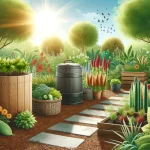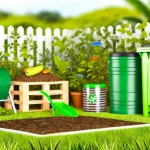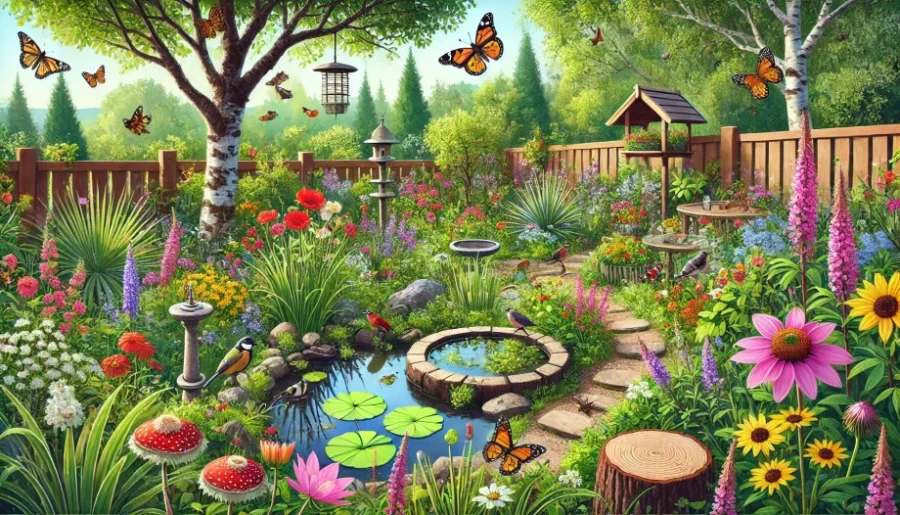
Wildlife friendly gardening is a rewarding way to support local wildlife right in your backyard. But are you missing the pollinators and birds?
Learn how you can transform your garden into a vibrant haven for wildlife. Ready to dive in? Let’s get started!
Wildlife Friendly Gardening Key Takeaways
- Wildlife Friendly Gardening is about creating a garden that provides food, water, shelter, and breeding spaces for local wildlife.
- Use native plants, add water sources, and avoid chemicals to make your garden a safe haven for birds, bees, butterflies, and more.
- It’s an easy way to support nature and enjoy a lively, vibrant garden.
Wildlife Friendly Gardening
Howdy everyone! Today, we’re diving into the wonderful world of wildlife-friendly gardening. It’s a fantastic way to give back to nature while creating a beautiful, buzzing garden space.
Whether you’ve got a tiny balcony or a sprawling yard, you can make a difference.
So, let’s get started on making your garden a haven for all kinds of critters!
Understanding Wildlife-Friendly Gardening
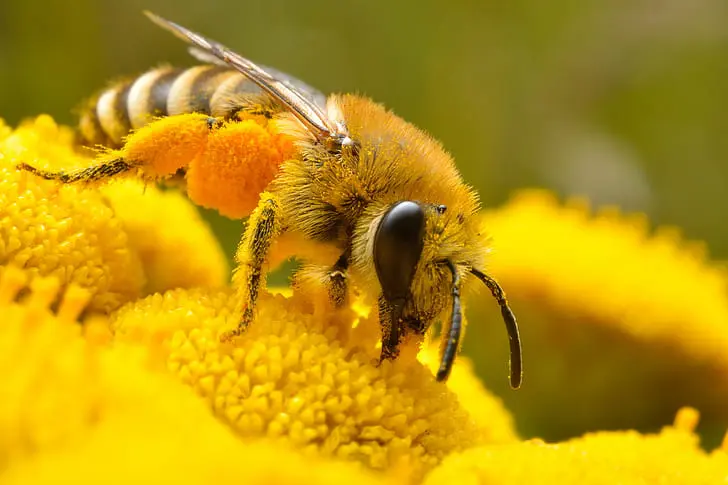
Creating a garden that’s friendly to wildlife isn’t just about planting a few flowers.
It’s about building a space that provides food, water, shelter, and a place for animals to raise their young.
By using native plants and avoiding chemicals, you can turn your garden into a safe, sustainable habitat for birds, bees, butterflies, and more.
Benefits of Wildlife-Friendly Gardens
Gardening for wildlife has many perks. Not only do you get to enjoy the sights and sounds of nature up close, but you also help support local ecosystems.
Native plants often require less water and maintenance, making your garden more sustainable.
Plus, attracting pollinators can boost the health of your plants.
Common Misconceptions
Many people think that a wildlife-friendly garden has to look wild and unkempt. That’s not true!
You can have a neat and tidy garden that still supports wildlife. It’s all about choosing the right plants and creating small habitats within your space.
Wildlife-Friendly Garden Ideas
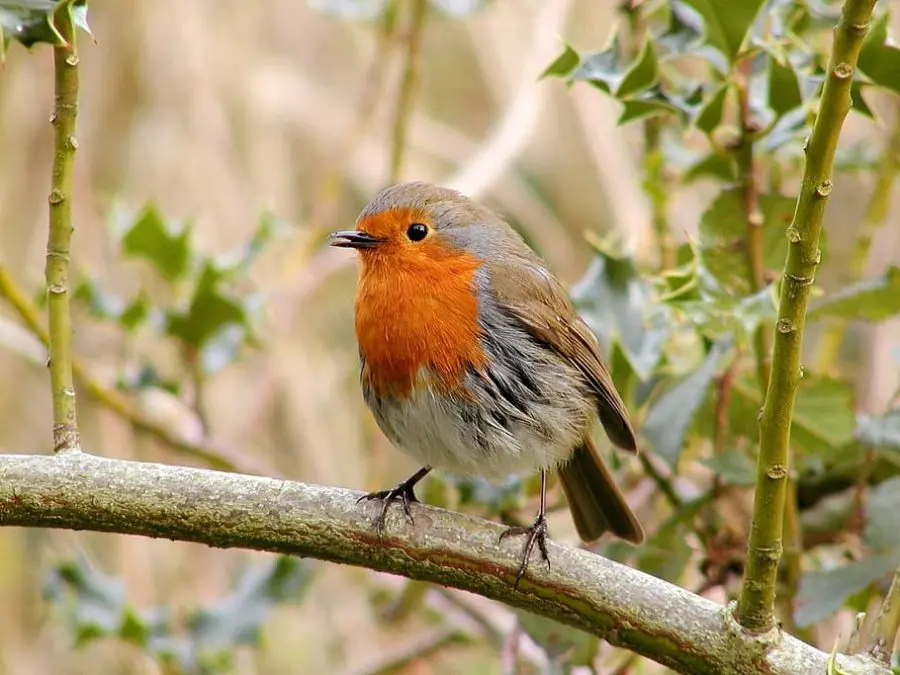
If you’re like me and love seeing your garden buzzing with life, then you’re in the right place.
Today, we’re diving into wildlife-friendly gardening ideas. It’s all about creating a space that’s inviting for birds, bees, butterflies, and other critters.
With a few simple tweaks, you can transform your garden into a thriving wildlife haven. Let’s get started!
Food Sources
Providing food is the first step to attracting wildlife to your garden. Here are some ideas to get you started:
-
Native Plants for Nectar, Seeds, and Berries
- Choose plants like coneflowers, sunflowers, and berry bushes.
- These plants are adapted to your local environment and provide essential nutrients for wildlife.
- They attract birds, butterflies, and other insects, creating a vibrant ecosystem.
-
Bird Feeders and Their Placement
Brushed Copper Wild Bird Feeder for Outdoors
-
- Install a variety of bird feeders to cater to different bird species.
- Place feeders in safe, accessible spots where birds can easily reach them but are protected from predators.
- Consider tube feeders for finches and chickadees, and suet feeders for woodpeckers.
Water Sources
Water is crucial for wildlife survival. Here are some ways to add water to your garden:
Outdoor Garden Bird Bath- Bronze- Weather Resistant Polyresin
A simple birdbath can provide drinking and bathing water for birds.
-
- Keep the water fresh and clean to prevent disease.
- Install a small pond to attract amphibians like frogs and toads, which also help control pests.
- Even a shallow water container can make a big difference; just ensure it’s safe and easy for wildlife to access.
Shelter and Cover
Wildlife needs places to hide from predators and harsh weather. Here’s how you can provide that:
-
Shrubs, Trees, and Log Piles
- Plant dense shrubs and trees to offer excellent cover for birds and small mammals.
- Create log piles to provide habitats for insects, amphibians, and even small mammals.
- These elements also help improve soil quality as they decompose.
Places to Raise Young
Providing safe places for wildlife to raise their young is crucial. Consider these options:
-
Nesting Boxes and Safe Planting Zones
- Install nesting boxes for birds, bats, and small mammals in quiet, sheltered areas.
- Create dense planting zones with plenty of foliage where animals can nest and raise their young in peace.
- Ensure these areas are away from too much human activity to provide a secure environment.
Sustainable Practices
Adopting sustainable practices ensures your garden remains a safe haven for wildlife. Here’s what you can do:
-
Organic Gardening Methods
- Use compost to enrich your soil instead of chemical fertilizers.
- Rotate your crops and introduce beneficial insects to control pests naturally.
- These methods keep your garden healthy without harming wildlife.
-
Avoiding Pesticides and Synthetic Fertilizers
- Opt for natural pest control alternatives like neem oil and insecticidal soap.
- Companion planting can also help keep harmful insects at bay.
- Using mulch and compost improves soil health without the need for synthetic fertilizers.
There you have it, folks! By incorporating these ideas, you can create a garden that’s not only beautiful but also a sanctuary for local wildlife.
Planning Your Wildlife Garden
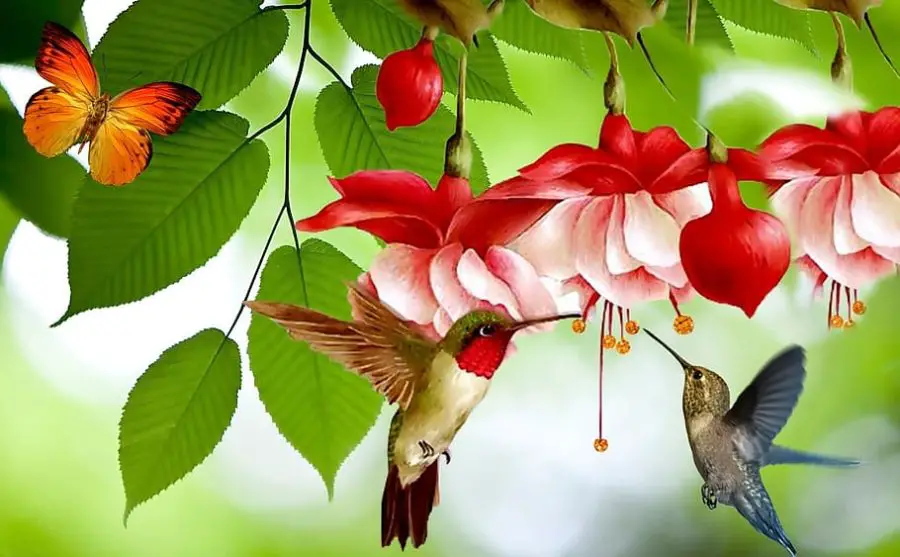
Are you ready to make your garden a paradise for wildlife? Planning your wildlife garden is key to creating a space that’s both beautiful and beneficial for birds, bees, and other critters.
By assessing your space and choosing the right plants, you can turn any garden into a wildlife haven. Let’s dive into the planning phase and get your garden ready for its new visitors!
Estimating Your Space
Before you start planting, it’s important to understand the space you have. Here’s how you can make the most of it:
-
Small Garden Ideas
- Use raised beds or containers to maximize planting space.
- Create mini-habitats with a mix of plants, water features, and hiding spots.
- Incorporate a variety of plant heights to add layers and depth.
-
Utilizing Vertical Space and Balcony Options
- Vertical gardens can be a lifesaver in small spaces. Use trellises and wall planters.
- Hanging baskets are perfect for adding more plants without taking up ground space.
- If you have a balcony, create a cozy wildlife corner with potted plants and a small birdbath.
Choosing Native Plants
Selecting the right plants is crucial for supporting local wildlife. Here’s how to pick the best ones:
-
Regional Recommendations
- Research native plants that thrive in your area. These are adapted to the local climate and soil, making them easier to maintain.
- Visit local nurseries or gardening centers for advice on the best native species.
- Join local gardening groups or forums to share tips and experiences.
-
Seasonal Plant Selection
- Plant a mix of species that bloom at different times of the year to provide continuous food sources.
- Consider plants that offer resources in multiple seasons, like shrubs that flower in spring and bear fruit in fall.
- Rotate annuals and perennials to keep your garden dynamic and attractive throughout the year.
By planning carefully and choosing the right plants, you can create a garden that’s not only beautiful but also a sanctuary for local wildlife.
Creating Specific Habitats
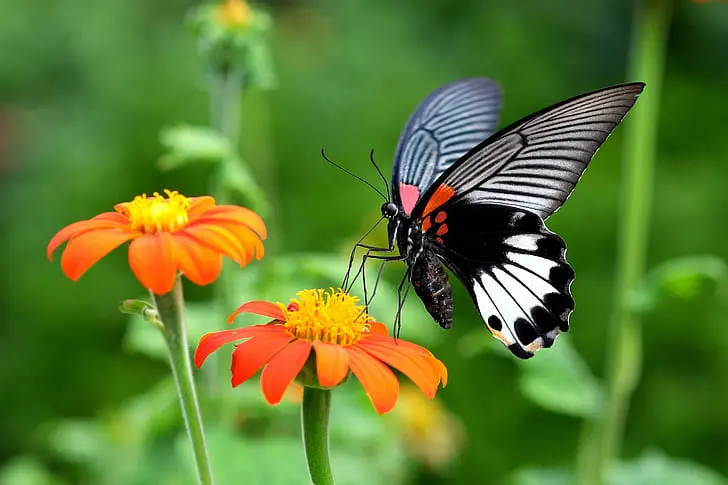
If you’re keen on creating a garden that welcomes all sorts of wildlife, this is for you.
Today, we’re focusing on creating specific habitats within your garden to attract a variety of creatures.
You’ll transform your garden into a bustling wildlife haven by designing spaces tailored for birds, butterflies, bees, amphibians, and mammals. Let’s explore these exciting ideas!
Birdscaping
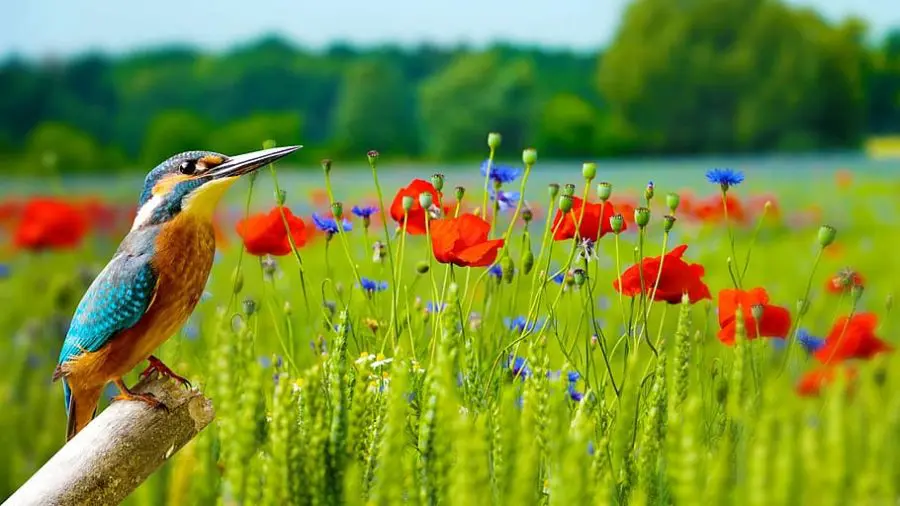
Birdscaping is all about making your garden inviting for our feathered friends. Here are some tips to get you started:
-
Plants that Attract Birds
- Plant native trees and shrubs that produce berries, seeds, and nectar.
- Consider plants like sunflowers, elderberries, and serviceberries.
- These plants provide natural food sources throughout the year.
-
Designing with Birdhouses and Feeders
- Install birdhouses in quiet, sheltered areas to encourage nesting.
- Use a variety of feeders to cater to different bird species.
- Place feeders in spots that are safe from predators and easy for birds to access.
Butterfly and Bee Gardens
Creating a haven for pollinators like butterflies and bees can be both beautiful and beneficial. Here’s how:
-
Flowering Plants for Pollinators
- Plant a mix of flowers that bloom at different times to provide a continuous food source.
- Choose native flowers like milkweed, lavender, and coneflowers.
- These plants offer nectar and pollen that attract and sustain pollinators.
-
Creating Butterfly Puddling Stations
- Butterflies need water and minerals, which they often get from mud puddles.
- Create a puddling station by placing a shallow dish filled with sand and water in your garden.
- Add a few flat stones for butterflies to rest on while they drink.
Amphibian Areas
Amphibians like frogs and toads are great for controlling garden pests. Here’s how to make them feel at home:
-
Building and Maintaining Wildlife Ponds
- Install a small pond in a shaded area to keep the water cool.
- Avoid adding fish, as they can eat amphibian eggs and larvae.
- Keep the pond edges gentle to allow easy access for amphibians.
-
Plants for Pond Edges
- Plant native aquatic plants like water lilies, cattails, and rushes.
- These plants provide cover and breeding sites for amphibians.
- They also help keep the water clean and oxygenated.
Mammal Habitats
Providing safe spaces for small mammals can add another layer of life to your garden. Here are some ideas:
-
Hedgehog Houses and Small Mammal Shelters
- Build or buy a hedgehog house and place it in a quiet, sheltered spot.
- Create small mammal shelters using piles of logs, leaves, and branches.
- Ensure these shelters are away from busy areas to keep the animals safe.
Creating Rock Piles or Stone Walls
- Construct rock piles or low stone walls as alternative shelters.
- These structures provide hiding spots and protection from predators.
- They also help create a variety of microhabitats for insects and small mammals.
By creating specific habitats in your garden, you can attract a diverse range of wildlife and enjoy the beauty and benefits they bring.
5. Enhancing Your Garden with Additional Features
Now that we’ve got the basics down, it’s time to kick things up a notch by enhancing your garden with some fantastic additional features.
These extra touches can turn your space into a thriving sanctuary for all sorts of wildlife.
Whether it’s adding mini-meadows or rock piles, these ideas will make your garden even more inviting. Let’s dive in and see what you can do!
Meadows and Grasses
Creating mini-meadows can significantly boost insect diversity in your garden. Here’s how:
-
Creating Mini-Meadows for Insects
- Select a sunny spot and sow a mix of wildflower seeds.
- Include native grasses to provide shelter and food.
- Mow the meadow once a year in late summer to encourage new growth.
Climbing Plants and Vines
Maximizing vertical space is perfect for small gardens and balconies. Here’s what you can do:
-
Maximizing Space with Vertical Gardening
- Use trellises, arbors, and wall planters for climbing plants.
- Choose native climbing plants like honeysuckle and clematis.
- These plants provide food and shelter for birds and insects.
Hedgerows and Natural Boundaries
Hedgerows are fantastic for privacy and wildlife habitat. Here’s how to incorporate them:
-
Using Native Hedges for Privacy and Wildlife Habitat
- Plant native shrubs like hawthorn, blackthorn, and holly.
- Create dense, layered hedges to provide shelter and food.
- Maintain hedgerows by trimming them in late winter to early spring.
Rock Gardens and Log Piles
Rock gardens and log piles create micro-habitats for various wildlife. Here’s how:
-
Micro-Habitats for Insects and Small Animals
- Build rock piles in sunny spots to provide basking areas for reptiles.
- Use logs and branches to create sheltered spots for insects and small mammals.
- Place these features in different parts of your garden to attract diverse species.
By enhancing your garden with these additional features, you can create a thriving, diverse habitat for all kinds of wildlife.
Low Maintenance Tips for Wildlife Gardens
Keeping a wildlife-friendly garden doesn’t have to be a lot of work. In fact, with the right strategies, you can create a beautiful, thriving habitat that practically takes care of itself.
Today, we’re diving into some low-maintenance tips for wildlife gardens.
From drought-resistant plants to mulching, these tips will help you enjoy a vibrant garden without the constant upkeep. Let’s jump in!
Drought-Resistant Plants
Choosing plants that can thrive with minimal water is a game-changer for a low-maintenance garden. Here’s what to consider:
-
Selecting Drought-Resistant Plants
- Look for native species adapted to your local climate, such as lavender, sage, and yarrow.
- These plants not only survive dry conditions but also attract pollinators.
- Group plants with similar water needs together to make watering more efficient.
Mulching and Ground Cover
Mulching and ground cover are essential for reducing garden maintenance. Here’s how to use them effectively:
-
Benefits of Mulching
- Mulch helps retain soil moisture, reducing the need for frequent watering.
- It suppresses weeds, saving you time on weeding.
- Organic mulches like wood chips or straw can improve soil health as they decompose.
-
Using Ground Cover Plants
- Plant ground covers like clover, creeping thyme, or sedum to keep weeds at bay.
- Ground covers protect the soil and provide habitats for insects.
- They also add visual interest with minimal upkeep.
Perennial Plants and Self-Seeding Annuals
Incorporating perennials and self-seeding annuals can make your garden both beautiful and low-maintenance. Here’s why they’re great:
-
Advantages of Perennials
- Perennials return year after year, reducing the need for replanting.
- They establish strong root systems, making them more drought-tolerant.
- Popular choices include coneflowers, black-eyed Susans, and hostas.
-
Benefits of Self-Seeding Annuals
- Self-seeding annuals like poppies, calendula, and cosmos come back each year with little effort.
- They can fill in gaps in your garden and add bursts of color.
- Let them go to seed, and you’ll enjoy new plants each season without lifting a finger.
By choosing drought-resistant plants, using mulch and ground covers, and incorporating perennials and self-seeding annuals, you can create a stunning, low-maintenance wildlife garden.
Engaging the Community
Today, we’re talking about a fantastic way to take your wildlife-friendly garden to the next level: engaging the community.
By working together with your neighbors and local organizations, you can create a network of habitats that support wildlife on a larger scale.
From creating wildlife corridors to participating in local conservation efforts, there are plenty of ways to get involved. Let’s see how you can make a bigger impact!
Creating Wildlife Corridors
Wildlife corridors are essential for allowing animals to move safely between different habitats. Here’s how you can help create them:
-
Connecting Green Spaces
- Work with your neighbors to connect gardens and green spaces, creating pathways for wildlife.
- Plant native hedges or use fences with gaps to allow animals to pass through.
- Encourage the use of green roofs and walls to provide additional habitat in urban areas.
-
Incorporating Safe Crossings
- Advocate for wildlife crossings in your community, such as overpasses or tunnels, to help animals cross roads safely.
- Mark existing crossings with signs to alert drivers to the presence of wildlife.
Participating in Local Conservation Efforts
Getting involved in local conservation projects can have a significant impact. Here’s how you can contribute:
-
Joining Local Groups
- Join local wildlife or conservation groups to stay informed and get involved in community projects.
- Participate in habitat restoration projects, such as tree planting or wetland restoration.
- Volunteer for local wildlife surveys to help track the health and numbers of local species.
-
Supporting Conservation Initiatives
- Support local and national conservation initiatives through donations or fundraising.
- Advocate for policies that protect local habitats and wildlife.
Educational Opportunities and Garden Tours
Sharing your knowledge and garden with others can inspire more people to create wildlife-friendly spaces. Here are some ideas:
-
Hosting Garden Tours
- Open your garden for tours to showcase how you’ve created a wildlife-friendly space.
- Partner with local gardening clubs or conservation groups to organize tours and workshops.
-
Providing Educational Resources
- Create and distribute educational materials on wildlife gardening at local community centers, libraries, and schools.
- Host talks or workshops to teach others about the benefits and methods of creating wildlife-friendly gardens.
By engaging your community, you can extend the impact of your wildlife-friendly garden and inspire others to join in.
FAQs
Well howdy everyone! I know many of you have questions about creating and maintaining a wildlife-friendly garden.
Here are some of the most frequently asked questions, along with practical answers to help you get started. Let’s dive in!
Q: What is the best garden for wildlife?
A: The best garden for wildlife includes a mix of native plants, water sources, and sheltered areas. Native plants provide food and habitat, while water sources like ponds and birdbaths meet hydration needs. Dense shrubs, trees, and log piles offer shelter and nesting sites. Aim for diversity to support a wide range of species.
Q: How to create a wildlife-friendly backyard?
A: To create a wildlife-friendly backyard, start by planting native species that offer food and shelter. Add bird feeders, bat boxes, and insect hotels to attract different animals. Include water features like birdbaths or small ponds. Avoid using pesticides and synthetic fertilizers to keep the environment safe for wildlife.
Q: How to design a better wildlife garden?
A: Designing a better wildlife garden involves creating diverse habitats. Use a variety of plants that bloom at different times to provide year-round food sources. Incorporate layers with trees, shrubs, and ground cover to offer multiple habitats. Add features like rock piles, log piles, and water elements to enhance biodiversity.
Q: What is a wildlife habitat garden?
A: A wildlife habitat garden is designed to provide food, water, shelter, and breeding sites for local wildlife. It includes native plants, water features, and safe nesting areas. Sustainable practices like composting and avoiding chemicals are key to maintaining a healthy environment for wildlife.
Q: How can I attract more wildlife to my yard?
A: Attract more wildlife by planting a variety of native plants, adding water features, and providing shelter. Bird feeders and nesting boxes can help attract birds. Leave some areas of your yard a bit wild with leaf litter and log piles for insects and small mammals. Minimize lawn space to make room for diverse plantings.
Q: Should you feed wildlife in your backyard?
A: Feeding wildlife can be beneficial, especially during harsh weather conditions. However, it’s important to offer appropriate food and to do so responsibly. Use bird feeders for seeds and suet, and avoid feeding human food scraps. Keep feeders clean to prevent the spread of disease.
Q: How to plan a natural garden?
A: Planning a natural garden involves mimicking local ecosystems. Choose native plants that thrive in your region. Design with nature in mind, incorporating diverse plant layers and natural features like ponds and rock piles. Use organic gardening practices to maintain soil health and support wildlife.
There you have it, folks! I hope these answers help you create and maintain a wildlife-friendly garden that buzzes with life.
Conclusion
Well howdy everyone! We’ve covered a lot of ground today, from planning your wildlife-friendly garden to enhancing it with additional features and engaging your community.
Creating a space that supports local wildlife is not only rewarding but also vital for maintaining biodiversity.
Let’s wrap up with some key takeaways and a call to action to get you started.
Key Takeaways
- Plan Your Space
- Assess your garden size and layout.
- Choose native plants that thrive in your region.
- Provide Essentials
- Include food sources like native plants and bird feeders.
- Add water features such as birdbaths and ponds.
- Create shelters with shrubs, trees, and log piles.
- Support Breeding
- Install nesting boxes and create safe planting zones.
- Sustainable Practices
- Use organic gardening methods.
- Avoid pesticides and synthetic fertilizers.
- Enhance with Features
- Create mini-meadows and use climbing plants.
- Add hedgerows and natural boundaries.
- Build rock gardens and log piles for micro-habitats.
- Engage the Community
- Create wildlife corridors.
- Participate in local conservation efforts.
- Offer educational opportunities and garden tours.
Call to Action
Start small, stay committed, and watch your garden transform into a wildlife haven. Every little bit helps, and with your dedication, you’ll create a thriving sanctuary for all kinds of critters. Happy gardening, and remember to keep it green!
Read more: Introduction to Sustainable Gardening: Comprehensive Guide
Resources
Howdy everyone! To help you on your journey to creating a wildlife-friendly garden, I’ve gathered some great resources from authoritative websites.
These links offer detailed information, tips, and inspiration to ensure your garden thrives and supports local wildlife. Check them out below!
- National Wildlife Federation (NWF)
- Learn about creating certified wildlife habitats and find comprehensive guides on native plants, sustainable gardening practices, and more.
- NWF Garden for Wildlife
- The Wildlife Trusts
- Explore practical advice on wildlife gardening, from choosing plants to creating specific habitats. They also offer resources for community engagement and conservation efforts.
- The Wildlife Trusts – Wildlife Gardening
- Royal Horticultural Society (RHS)
- Find a wealth of information on gardening for wildlife, including plant recommendations, design tips, and sustainability practices.
- RHS Wildlife Gardening
- Audubon Society
- Discover bird-friendly gardening tips, native plant databases, and ways to create habitats that support bird populations.
- Audubon Society – Plants for Birds
- Garden Design
- Offers design ideas and tips for creating a wildlife-friendly garden, including specific habitat features and plant suggestions.
- Garden Design – Wildlife Gardening
These resources will provide you with the knowledge and inspiration to make your garden a haven for wildlife. Happy gardening, and remember to keep it green!



